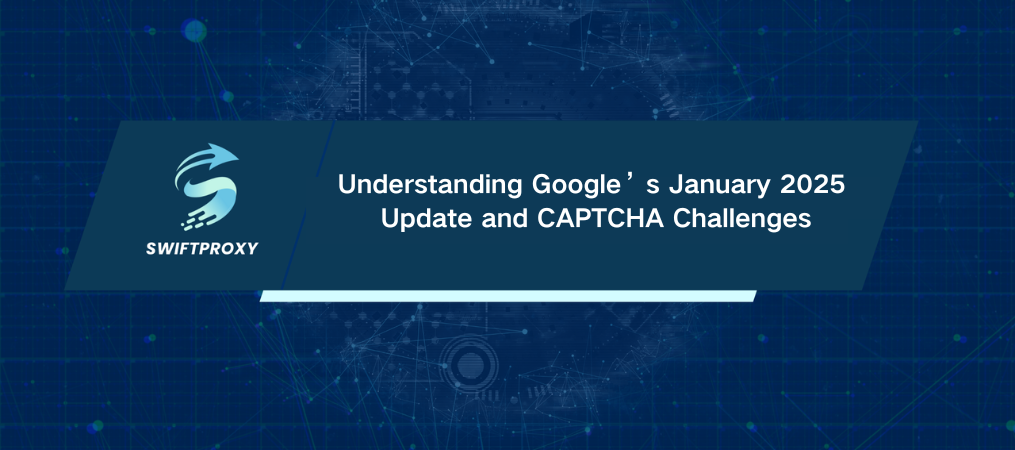Understanding Google's January 2025 Update and CAPTCHA Challenges

On January 16, 2025, Google rolled out an update that shook the world of web scraping. This wasn't just any algorithm tweak – it was a leap forward in Google's fight against automated bots, triggering a rise in CAPTCHA challenges for users scraping data from Google's search results. If you're one of the many who saw this spike and thought, "My proxies must be failing," think again. This isn't a proxy issue – it's Google's evolving security protocol in action. Let's break it down and understand why you're seeing these CAPTCHA prompts and how they don't reflect the quality of your proxy service.
Google's Continued Fight Against Web Scraping
For years, web scraping has been a thorn in Google's side. Scrapers distort search results, violate terms of service, and potentially damage the integrity of Google's data. To keep this in check, Google's algorithms have become more advanced, evolving to detect and block bot traffic. With the Google's January 2025 update, the search giant strengthened its defenses, making it harder for automated systems to sneak through undetected.
Now, Google's algorithms are smarter than ever. They analyze a range of data points – from traffic patterns and IP behaviors to user interaction signals – to spot bots hiding behind the screen. The end result? More CAPTCHA challenges for users scraping Google search results for SEO, research, or data gathering.
The Role of CAPTCHA in Google’s Anti-Bot Strategy
CAPTCHA – that dreaded test to prove you're human – is Google's primary tool for filtering out bots. It's triggered when Google detects anything out of the ordinary. Unusual patterns like high request volumes, repetitive actions, or user-agent behavior that mimics bots? That's a red flag. But here's the catch: seeing a CAPTCHA doesn't mean your proxy is bad.
Google's not just blocking IPs. It's analyzing behavior patterns. Even top-notch proxies, with automatic rotation and geographical diversity, can fall victim to Google's detection systems if the scraping activity triggers certain red flags. Here are a few behaviors Google flags:
· Request Timing: Too many requests in a short period? It looks suspicious.
· Traffic Patterns: Repeated actions from a single IP or unusual patterns can raise alarms.
· Geographic Position: A narrow geographic range might seem off to Google's algorithms.
Why CAPTCHA Challenges Don't Indicate Poor Proxy Quality
We know how frustrating it is to deal with CAPTCHA when you're relying on high-quality proxies. But here's the truth: CAPTCHA prompts don't signal proxy failure. Your proxies are still doing their job – hiding your real IP address and maintaining your anonymity. The issue is that Google's algorithm is sophisticated enough to look beyond the IP and spot behavior it deems suspicious.
If you're scraping too fast, from a single location, or repeating actions in an automated pattern, Google will see that as bot-like activity and challenge you with a CAPTCHA. This isn't a proxy issue; it's a preventive measure by Google to protect its search results from abuse.
Tips for Minimizing CAPTCHA Interference
While CAPTCHA challenges are a predictable part of Google's anti-bot defense, there are ways to minimize their impact and keep your scraping running smoothly. Here are some actionable strategies to reduce CAPTCHA encounters and improve your scraping efficiency:
· Leverage Rotating Proxies: Switch up your IP addresses with a proxy service that rotates IPs regularly. This creates more diverse traffic patterns, reducing the likelihood of being flagged as a bot.
· Regulate Request Frequency: Spread your scraping activities over time. Instead of sending thousands of requests in a short burst, collect data gradually. Google's algorithms will appreciate the more natural, organic traffic flow.
· Use CAPTCHA-Solving Solutions: If a CAPTCHA does pop up, there are automated services that can quickly solve it for you, keeping your data collection moving.
· Use Multiple IP Locations: Using proxies from various geographical regions helps to make your traffic appear more like legitimate, global user traffic, lowering the chances of triggering a CAPTCHA.
· Model Human Behavior: Adjust your scraping tool to mimic human browsing behavior. Rotate user agents, randomize request intervals, and use browser fingerprints to make your traffic look more authentic.
By combining these best practices with a premium proxy service, you'll be equipped to bypass Google's toughest anti-scraping measures. The key is a balanced approach – make sure your scraping behavior mirrors that of a real user. This is the best way to avoid those pesky CAPTCHA challenges and scrape data efficiently.

















































